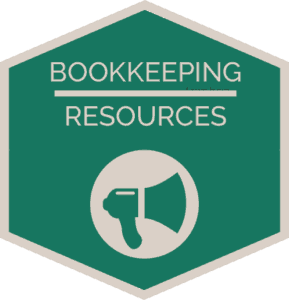Every year, business owners stress in secret as tax season looms nearer. Bookkeeping isn’t always first on the to-do list, and it often gets saved until the very last minute (cue tax season panic…).

However, catching up on your bookkeeping is not as daunting a task as it seems. What most business owners lack is a simple system to follow.
The key is to prep and organize your documents BEFORE you put them into your spreadsheet or your bookkeeping software.
With that said, here are 4 simple steps to getting caught up on your books:
1. Make a list of all the bank accounts associated with your business
I call this my “Big Bookkeeping Checklist.” (We’ve made one you can fill in yourself with our Easy Bookkeeping System).
You must do this first and foremost because ALL of the following steps depend on making sure you have all your information in one place.
Bank accounts associated with your business should include ALL accounts like: checking, savings, credit cards, Paypal – you get it.
You’ll want to keep this list handy so you can refer back to it every month. When you sit down to do your bookkeeping, it’s important to check every account and transaction. Keeping a handy checklist of all of your business-related accounts makes catching up on your bookkeeping much easier to do throughout the year. And with a list you can also keep current on your bookkeeping, and imagine how freeing that would feel.
2. Download statements for EVERY month (and copies of any checks you wrote) for EACH of those accounts
You’ll want to do this for the time period you’ll be organizing. So, if you are 6 months behind on your bookkeeping, you’ll want statements and check copies for ALL 6 MONTHS.
Pro-tip: set a reminder on your phone to do this once a month going forward. That way, you don’t have to do it all at once. This is helpful for two reasons:
1. If you’re still writing checks, some banks can charge you up to $20 PER CHECK after a certain period of time. If you’re ever audited, and you need a bunch of check copies you don’t have… that could mean HUNDREDS of dollars down the drain.
2. Similarly, banks can make it super hard to obtain your statements after a certain period of time (this changes from bank to bank!). It’s ESPECIALLY hard if you have closed those accounts (i.e. you most likely won’t be able to access them online, which means – gulp – snail mail).
3. Create a digital folder to organize these documents
I highly recommend saving this folder to a cloud-based storage solution!
Technology, as we know, can be a fickle pickle. Don’t risk losing your financial info and bookkeeping records! Like we said, it can be expensive to obtain backlogged records and documents.
4. Decide how to track your expenses and your income
You’ll need to go through each of your statements and record and categorize allllll of your transactions (What was income? What was an office expense? What was an asset purchase?).
If your business is small, a simple spreadsheet may suffice for this process. If your business is a bit bigger, you might want to invest in a software like QuickBooks Online. (I love QuickBooks because it connects to your bank accounts and AUTOMATICALLY categorizes expenses for you once you set it up correctly – wow chicka wow wow 🥰).
If you have multiple streams of income, investing in a bookkeeping software can save you a lot of mental energy down the road for this reason!!

It’s simple when you break it down!
Every business owner needs 4 things when it comes to getting caught up on your bookkeeping:
- A list of your bank accounts
- All of your statements and check copies for each of those accounts
- A digital place to organize them
- A way to track and categorize your income and expenses
Once you take some time to follow these four steps and clean up your books, you will gain valuable insight into what’s working in your business.
Once you have your numbers laid out, you can download a free Profit + Loss template, input your total expenses and income for the year or for a certain time period, and find out if your business was profitable. Added bonus: you can use this document to file your taxes after you complete it for the year.
With this info, you can have an accurate snapshot of your business (and whether you can afford to hire that VA or take that new marketing course!).
Need to get caught up on your bookkeeping and don’t know where to begin?
NEVER FEAR – I have just what you need, friend!
Check out The Easy Bookkeeping System: The Entrepreneur’s Step-by-Step Guide on How to Get (and Keep) Your Finances Organized. I designed it to help stressed out, time-starved entrepreneurs.
This is the exact system we have used at Good Cents for the past 13 years to help us keep our client’s books organized! It makes small business bookkeeping SIMPLE, so you can finally stop putting it off and start being an empowered entrepreneur who knows your numbers!
If you’re many months or YEARS behind on bookkeeping, check out our retroactive bookkeeping services, and we’ll take the stress off your shoulders!
P.S. This post contains affiliate links for awesome products we love!

